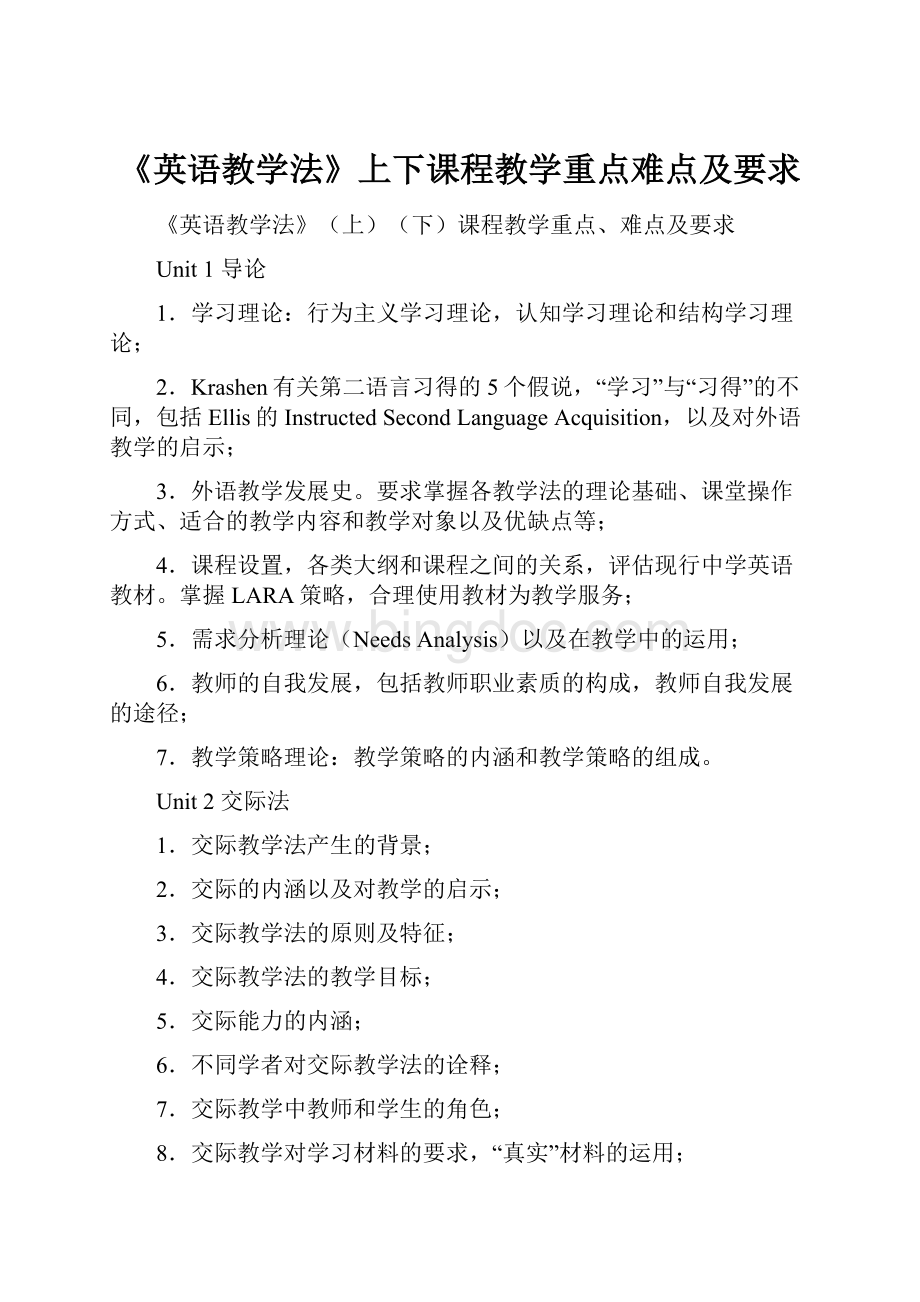《英语教学法》上下课程教学重点难点及要求文档格式.docx
《《英语教学法》上下课程教学重点难点及要求文档格式.docx》由会员分享,可在线阅读,更多相关《《英语教学法》上下课程教学重点难点及要求文档格式.docx(15页珍藏版)》请在冰点文库上搜索。

5.交际能力的内涵;
6.不同学者对交际教学法的诠释;
7.交际教学中教师和学生的角色;
8.交际教学对学习材料的要求,“真实”材料的运用;
9.交际教学课堂活动的安排,所采用的教学模式;
10.交际活动的内容;
11.根据自己的教材设计一堂交际教学课。
Unit3阅读教学
1.“阅读”的内涵,掌握有关阅读的几种观点,包括心理猜测理论和互动阅读理论。
2.影响有效/流畅阅读的因素;
3.有关良好阅读者的研究;
4.阅读教学中学生动机的激发;
5.阅读教学模式:
top-downapproach,bottom-upapproach和interactiveapproach;
各模式的理论依据,课堂操作方式,优缺点等;
6.阅读的层次,包括readthelines,readbetweenthelines和readbeyondthelines(plainsensereading,deductivereading,projectivereading)。
能举例说明各阅读层次,如何开展教学活动培养三层阅读理解能力;
7.阅读过程:
pre-reading,while-reading和post-reading。
各阶段活动如何开展,运用的是什么教学模式,可开展哪些活动。
要求能够就具体材料设计出各阅读阶段的教学活动,写成教案,进而在班内演示,能充分讨论具体材料的各种可能性操作;
8.阅读策略的培养,包括theStrategicTeachingMode,theCognitiveAcademicLanguageLearningApproach和theReciprocalTeachingApproach。
Unit4听力教学
1.现实听与课堂听的不同,以及对外语教学的启示;
2.影响听力的因素;
3.听力教学中学生动机的激发;
4.听力教学模式:
bottom-upapproach,top-downapproach和interactiveapproach。
掌握各类模式的操作方式;
5.听力教学的内容,如何教授和训练这些内容;
6.听力策略和听力教学策略有哪些;
7.听力材料的选择;
8.听力教学活动的安排;
9.听力教学的过程:
pre-reading,while-reading和post-reading,各阶段的教学目的,操作方式和可采用的活动。
要求根据具体学习材料写出每一阶段的教案并在班内演示,充分讨论各种操作方式的适用性,有效性等。
Unit5口语教学
1.现实生活中的口头交际特点以及对外语教学的启示;
2.会话技巧及其培养;
3.口语课的教学内容;
4.口语课的教学原则;
5.口语课的课堂教学模式,包括3P模式和task-basedapproach;
6.口语课的课堂教学程序:
presentation,practice和production。
掌握展示的内容、技巧方法和有效的教学活动。
要求能根据具体的学习材料设计各阶段的教案。
《英语教学法》(下)
Unit6写作教学
1.“goodwriting”的6大特点;
2.写作教学的原则;
3.写作教学的模式:
结果定向(product-orientedapproach),内容定向(content-orientedapproach),过程定向(process-orientedapproach)和交际定向(communication-orientedapproach);
4.写作的基本要求;
5.过程定向写作模式的写作教学过程:
pre-writing,drafting,revisingandediting,和seconddrafting;
6.写作与其它活动的结合。
Unit7语法教学
1.显性语法教学和隐性语法教学;
2、语法教学的原则(动机原则,效率原则,变化原则,全面原则,程序原则,交际原则和手段原则)是什么,在教学中如何体现;
3、语法教学的模式:
演绎教学模式(deductiveapproach)、归纳教学模式(inductiveapproach)和基于任务的教学模式(task-basedapproach);
4、语法教学的程序:
presentation,practice,production和evaluation;
5、阅读和听说课中的语法教学。
Unit8词汇教学
1.
词汇教学的内容(意义,语法,信息和运用);
2、单词的记忆方法以及对教学的启示;
3、词汇的选择,即教学中词汇选择的标准;
4、词汇教学的过程教学模式:
“展示”“运用”和“测评”;
5、词汇学习的策略和词汇记忆技巧;
6、词汇教学中学生学习动机的激发;
7、要求能根据具体语言材料撰写词汇教学教案,设计出词汇教学的活动。
Unit9备课
“lesson”所包含的内容(至少5部分);
2、影响“教案设计”的因素(物理因素,人文因素和大纲因素);
3、教案设计中应考虑的因素(至少8条);
4、“教案”的组成部分;
5、教案设计中对教材的处理;
6、教案的两种格式:
图表式和文字叙述式;
7、教案的语言要求;
8、将本单元教案的撰写与听、说、阅读、写作等具体课型联系起来,要求根据具体的课程材料写出教案。
Unit10andUnit11课堂管理(上)(下)
1、影响课堂组织的因素;
2、课堂组织的内容;
3、课堂组织中教师的角色;
4、课堂组织中课堂交互模式;
5、教师指令给予的原则;
6、课堂教学中教师如何“纠错”;
7、如何创造舒适的学习环境及如何激发学生的动机;
;
8、课堂教学中的提问在课堂组织中的运用,提问的策略;
9、如何处理不守纪律的学生及学生之间的不平衡;
10、应能举出课堂组织的各种实例,综合各个学生的意见,讨论处理方式的得体性,挖掘其对语言学习,语言教学,以及教育和心理学知识的运用;
11、如何在教案中展示课堂组织的方式。
Unit12测试
1.测试类型;
2.测试设计的基本原则;
3.设计阅读、词汇、语法、听力、写作等各项能力的测试;
4.阶段测试与教学的关系;
5.学习进度情况测试。
英语教学法
(2)样题
SectionI.BasicTheoriesandPrinciples(30points)
Directions:
ChoosethebestanswerfromA.B.orCforeachquestion.WriteyouranswerontheAnswerSheet.
1.Whatkindofcohesivedevicesisusedtolinksentencesthroughsignalingrelationshipsbetweensentencesbymeansofanaphoraorbackreference?
A.Cohesivedevicesthatindicatemeaningrelationshipsbetweenorwithinsentences,suchasapartfrom,inorderto,since,however,notonly,andbutalso.
B.Grammaticaldevicesthatestablishlinkstofromthecohesionofatext,suchasit,this,the,here,that,andsoon.
C.Lexicaldevicesthatusetherepetitionofkeywordsorsynonymouswordstolinksentencestogether.
2.Whatwillagoodwriterusuallydointhepre-writingstageofthewritingprocess?
A.Makedecisionsonthepurpose,theaudience,thecontents,andtheoutlineofthewriting.
B.Concentrateongettingthecontentrightfirstandleavethedetailslikecorrectingspelling,punctuation,andgrammaruntillater.
C.Developarevisingchecklisttopinpointtheweaknessesofhis/herwritingandfocusontheflawslikelytoappearintheirdrafts.
3.Writingexerciseslikecompletion,reproduction,compression,andtransformationaremainlythetypeofexercisesusedinwhichwritingtasks?
A.Controlledwriting.
B.Guidedwriting.
C.Freewriting.
4.Whichtypeofgrammartendstoteachyouhowthegrammarisusedbythepeopleratherthanhowitshouldbeused?
A.Descriptivegrammar.
B.Prescriptivegrammar.
C.Traditionalgrammar.
5.Whenthestudentsaregiventhestructureinanauthenticornearauthenticcontextandareaskedtoworkouttheruleforthemselves,whatkindofmethodtheirteacherisusing?
A.Deductivegrammarteaching.
B.Inductivegrammarteaching.
C.Traditionalgrammarteaching.
6.InwhichstageofthePresentation-Practice-Productionapproachwillstudentshavethechancetousethelanguagefreelyandincorporateitintotheirexistinglanguage?
A.PresentationStage.
B.PracticeStage.
C.ProductionStage.
7.Howcanwehelpstudentstomemorizeanewwordmoreeffectively?
A.Putthenewwordinacontext,relateittoknownwords,anduseillustrations.
B.Pre-teachthenewwordofatext,pronounceitcorrectly,andgroupit.
C.Putthenewwordinalistofunconnectedwordswithillustrations.
8.Whichofthefollowingtechniquescanbestpresenttheword“pollution”?
A.Showordrawapicture.
B.Giveadefinitionoranexample.
C.Demonstratethemeaningbyactingormiming.
9.Whethertwowordsgotogetherwitheachotherornotisanissueofwhat?
A.Connotation.
B.Register.
C.Collocation.
10.Amongthefollowingfactorsthatmayaffectalessonplan,whichoneincludesclassroomsize?
A.Humanfactors.
B.Physicalconditions.
C.Syllabusandtesting.
11.Whatarethemostimportantpartsofalessonplan?
A.Textbooksandclassroomaids.
B.Anticipationofproblemsandflexibilityindealingwiththem.
C.Objectivesofthelessonandproceduretoachievethem.
12.Whydoweneedtodesigntaskstosupplementthetextbook?
A.Textbooksusuallyarenotwellwritten.
B.Textbooksneedadaptationstofittheneedsoftheirtargetstudents.
C.Textbooksonlycoveralimitedamountoflanguageskills.
13.Amongthefivesubcategoriesofclassroommanagement,thatispeople,language,environment,organizationandtools,whichofthefollowingelementscanbeclassifiedunderenvironment?
A.Textbook,exercisebook,teacher’sbook,andblackboard.
B.Interactionbetweenteacherandstudents.
C.Arrangementofdesksandchairs.
14.Whatroledoesateachertaketocreateanenvironmentinwhichlearningcantakeplace?
A.Instructor.
B.Manager.
C.Assessor.
15.Wholeclassteaching,pairwork,groupwork,andgamesareactivitiesunderwhichsubcategoryofclassroommanagement?
A.People.
B.Environment.
C.Organization.
SectionII:
ProblemSolving(30points)
Belowarefivesituationsintheclassroom.Eachhasaproblem.First,identifytheproblem.Second,provideyoursolutionaccordingtothecommunicativelanguageteachingprinciples.Youshouldelaborateontheproblem(s)andsolution(s)properly.WriteyouranswerontheAnswerSheet.
16.Inawritingclass,theteacherasksthestudentstowriteanarticleabouttheirhometown.Tohelpthestudents,theteacheralsoprovidesawell-writtenarticleabouthometownbyafamouswriterasasample.Studentsareinstructedtofollowthestyleandtheorganizationofideasofthesamplearticle.
17.Inagrammarclass,theteacherteachestheuseof“some”and“any”inthefollowingway:
A.Explainstherulesoftheirusage.
B.Providessomeexamplestoillustratetheusageofthetwowords.
C.Askthestudentstodopatterndills.
D.Askthestudentstoapplytherulestogivensituations.
18.Whenteachinganewreadingpassage,theteacherwritesallthenewwordsontheblackboardandasksthestudentstolookthemindictionaries.ThentheteacherexplainsthemeaningofthesenewwordsinsimpleEnglish,usuallybyprovidingsomeexamplesoftheirusage.Sometimes,theteachermayprovidetheChineseversionsforthesewords.Afterdealingwiththevocabulary,theteacherwillthenshifttheirfocustothereadingpassage.
19.Whenpreparingalesson,someteachersjustrelyontheteacher’sbook.Beforeteachingalesson,theywilljustlookupthenewwordsinthedictionaryandcopyparaphrasesfromtheteacher’sbookontothestudent’sbook.Inclass,theywilljustfollowtheinstructionsprovidedbytheteacher’sbook.
20.Thisisatraditionalclassroom.Thestudent’sdesksarearrangedneatlyinrowsandcolumns,whiletheteacher’sdeskisplacedinthefronttheclassroomonaplatform.Theteachercomesintotheclassroom.Allstudentsstanduptogreettheteach